
Ellisland Farm lies about 6.5 mi/10.4 km northwest of Dumfries near the village of Auldgirth, located in the Parish of Dunscore, Dumfries and Galloway, Scotland. The complex is a museum in the farm Robert Burns built, lived in and farmed from 1788 until 1791. One of the earliest references to the site is in 1465. Cardinal Antonius confirming a Charter by the Monastery of Melrose of the adjoining property of Ellisland to John Kirkpatrick.
Jean Glover or Jennifer Glover (1758–1801) was a Scottish poet and singer. She was the daughter of James Glover, handloom weaver and Jean Thomson, born in Townhead, Kilmarnock; was well educated for the time she lived in, clever and sharp-witted. She had a fine singing voice and exceedingly good looks of "both face and figure".

Nelly or Nellie Kilpatrick, Helen Kilpatrick or later Nelly Bone (1759–1820). Nelly was possibly Robert Burns's first love and muse as stated by Isabella Burns.
Margaret "Peggy" Thompson, later Margaret Neilson, was the housekeeper at Coilsfield House or Montgomery Castle in Ayrshire, Scotland. She married John Neilsen of Monyfee. The couple lived at Minnybae Farm near Kirkoswald. She was the 'charming Fillette' of Robert Burns fame and her husband was an old acquaintance of the poet.

Alison Begbie, Ellison Begbie or Elizabeth Gebbie (1762–1823), is said to have been the daughter of a farmer, born in the parish of Galston, and at the time of her courtship by Robert Burns she is thought to have been a servant or housekeeper employed at Carnell House, then known as Cairnhill, on the River Cessnock, situated about 2 miles from Loudoun Mill. It is thought that Burns's youngest sister Isobel Burns confused her name, which was really Elizabeth Gebbie.

Elizabeth "Betsey" Paton or later Elizabeth Andrew of Lairgieside was the daughter of James Paton and Eleanor Helen Paton of Aird Farm, Crossroads, Ayrshire. Following an affair with Robert Burns she gave birth on 22 May 1785 to his first child, Elizabeth "Bess" Burns, the "Dear-bought Bess", who was baptised when only two days old. Betsey met Robert Burns when she was employed as a servant girl at the Burns's Lochlea Farm during the winter of 1783–84. When the Burns family moved to Mossgiel Farm in March 1784, Betsey returned to her own home, where Robert Burns visited her later that year. In 1786, Elizabeth made a claim on Burns, but accepted a settlement of twenty pounds which the poet paid out of the profits of the Kilmarnock Edition. Loving Burns with heartfelt devotion, she continued to see him after the Burns family had moved to Mossgiel Farm, and he returned these sentiments with more physical than spiritual devotions. Isabella Begg, Burns's youngest sister, stated that although Robert did not love her, "he never treated her unkindly."
Janet, Jennie or Jenny Clow was a domestic servant to Mrs Agnes Maclehose, née Craig (1759-1841), the Clarinda to Robert Burns' Sylvander. She was the daughter of Andrew Clow and Margaret Inglis from Fife and was the youngest of eight children. Her mistress sent her to deliver a letter to the poet and he seduced her.

Helen Anne Park, known as Anna Park or Ann Park, was born in 1769 at Moffat, Scotland. She was thought to have been the daughter of Joseph Park, an Edinburgh coachmaker, and Jean Dick. However, recent research has shown that she was actually the daughter of Walter Park and Elizabeth Blacklock. Margaret Ewing née Park, a onetime landlady of 'The Globe', was her sister and she worked there as a barmaid. Anna bore the poet Robert Burns an illegitimate child named Elizabeth 'Betty' Burns as a result of an adulterous affair.
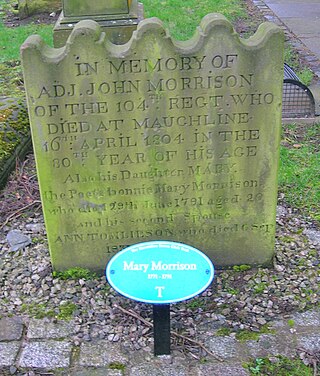
Mary Morison or Mary Morrison, may have been the "lovely Mary Morison", whom the poet Robert Burns admired as a girl of sixteen. She was the daughter of Adjutant John Morison of Mauchline.
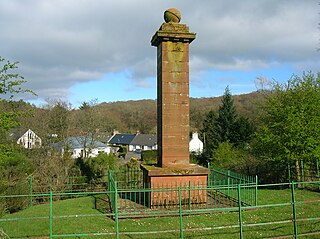
Mary Campbell, also known as Highland Mary, was the daughter of Archibald Campbell of Daling, a sailor in a revenue cutter, whose wife was Agnes Campbell of Achnamore or Auchamore. Mary was the eldest of a family of four. Robert Burns had an affair with her after he felt that he had been "deserted" by Jean Armour following her move to Paisley in March 1786. The brief affair started in April 1786, and the parting took place on 14 May of that year. Her pronunciation of English was heavily accented with Gaelic and this led to her becoming known as 'Highland Mary.'
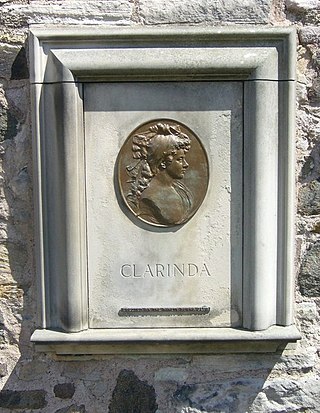
Agnes Maclehose, or Agnes Craig, known to her friends as Nancy and to Robert Burns followers as Clarinda, was a Scotswoman who had an unconsummated affair with Burns during 1787-88, on which he based the 1791 song "Ae Fond Kiss". The pseudonyms of her "Clarinda" to his "Sylvander" were adopted by the pair for confidential correspondence purposes. Maclehose, used here throughout, has been various styled, including "McLehose", "MacLehose" and "M'Lehose".

Richard Brown or Ritchie Broun in Scots was born in Irvine. He was a sea captain and a one time friend of Robert Burns who is credited by Burns as the being the person who "encouraged me to endeavour at the character of a Poet."
Nelly Blair, later Nelly Smith is sometimes suggested as being Scottish poet Robert Burns' first love.
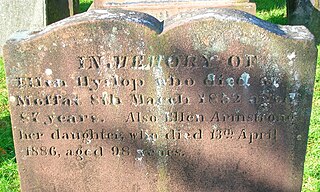
Helen Hyslop, also Nelly or Ellen Hyslop was a 'noted local beauty' in Moffat and a strong local tradition maintains that Robert Burns was for some time a great admirer of her and that she had an affair with him. A daughter, also Helen, is said to have been born as a result of this liaison. Parish records show that a Helen Hyslop, the mother of Burns's possible daughter, was born in the area in 1766, her parents being John Hyslop and Janet Howatson of Langholm.
Jean Gardner or later Jean Hill, was "a young woman of very surpassing beauty," with a "light foot and an ensnaring eye," but she may have been thirteen years older than Robert Burns with whom she was on friendly or 'intimate' terms. A strong local tradition in Irvine links her with Robert Burns, however no contemporary written evidence records this relationship and Burns himself is not thought to have written about her, other than a disputed use of her given name as the 'darling Jean' of Burns's 'Epistle to Davie', and most recent writers have considered the reference to be to Jean Armour.
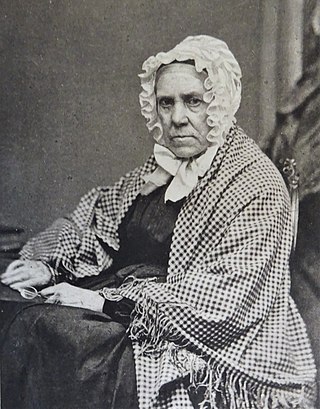
Elizabeth Burns, Elizabeth Park or Mrs John Thomson known as Betty Burns, was born in 1791 in Leith, Scotland. She was the illegitimate daughter of Robert Burns and Anna Park who was a barmaid at The Globe in Dumfries. She married John Thomson in 1808 to become Elizabeth Thomson.

John Richmond (1765–1846) was one of Robert Burns's closest friends and confidants. He was born in Sorn parish at Montgarswood, Ayrshire, Scotland. His father, Henry Richmond, was a merchant in Mauchline and owned Montgarswood Farm that lies near Sorn. This farm passed to James, John's brother, having once been farmed by William Fisher, Burns's Holy Willie.

Alexander Cunningham was one of Robert Burns's closest friends from his time in Edinburgh. They stayed in contact, through at least 19 letters from the poet; and Cunningham was the ardent admirer who encouraged and joined others such as John Syme to raise funds for the poet's family after his death. Cunningham was one of the small group of associates whom Burns actively approached for constructive criticism of his work.

Robert Ainslie (1766–1838) was a Scottish lawyer, and one of Robert Burns's long-term friends from his Edinburgh days. He was probably the closest confidant of Burns, whom he met first at a Masonic or Crochallan Fencibles event. Ainslie accompanied the poet on the first part of his Border Tour. Robert's father, also Robert, was a lawyer a bailie at Duns and a land-steward on Lord Douglas's Berwickshire estates. Robert married Jean Cunningham on 22 December 1798.
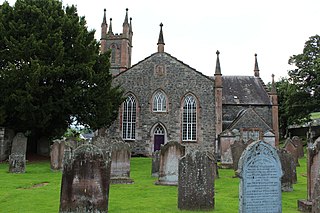
William Nicol (1744–1797) was a Scottish schoolmaster, and, if ill-tempered and vain, one of Robert Burns's close friends. He was born in Annan parish at Dumbretton, Dumfries and Galloway, Scotland. Burns referred to him in one letter as "Kind hearted Willie" and he accompanied the poet on his August 1787 tour of the Highlands. Burns's third son, William Nicol, born at Ellisland Farm in 1791, was named after his friend, the poet commenting that his newborn son had "that propensity to witty wickedness and manfu' mischief, which even at twa days auld I foresaw would form the striking features of his disposition."
















